The scoop on planting roses
First let's look at that sunny (more than 4 hours direct sun; no skimping) spot in the yard. How's the water situation? Roses like plenty of moisture, but hate boggy situations and will express their distaste by simply dying! If the area is really wet I'd recommend that you plant roses in a raised bed, building a containment of rock, block or railroad ties that give another two feet or so of planting depth above the existing soil profile.
Just a little damp? Adding sand can help slightly moist soil if it's just a little damp, but unless more than 30% of the total soil volume is sand it will actually hold MORE water. And sand decreases fertility so I feel raising the bed is really the best way to go (unless you like the idea of native roses like R. nitida or R. palustris, both wild swamp specialists from the eastern half of the States and hard to find in the trade).
What if the soil isn't wet but really dry? We can amend the soil with peat, manure humus and compost (preferably all of the above) and till it in to a good 12"depth OR we can build the raised bed again and have total control of what our soil is like! If it sounds like I like raised beds for roses there is a good reason. One, I do and secondly (and more importantly), roses are about as fussy as any plant out there about soil conditions. If we start by tilling, sure we have given them the fluffy, light soil they like but we've also tilled up dormant weed seed (Crabgrass, for instance, can lay dormant for 100 years!) and the last thing a rose wants is root competition from a hungry feeder like grass. Give raised beds a look.
Landscape roses
Groundcover roses like Flower Carpets or the Pavement series offer beautiful solutions for that tough hillside or narrow strip along the parking area that were the traditional haunts of Blue Rug Juniper. These and other landscape roses are just that; roses to be used in the landscape, not bedded down delicately like some of their sissy cousins. Certainly it improves the plant to get some soil amendment but nothing more than you would do for an azalea or spirea. These tough guys don't ask for any special treatment and they are ready to take on hard areas in your landscape so don't overlook these roses, especially if you might miss a week or three of gardening on occasion…
How do I plant my rose?
This is a fairly simple process but we first need to know what we're planting. Roses are sold a few different ways. Bare-root roses (often called box roses) are found in many garden centers and this is the usual way to get them if you have them shipped in the mail. I maintain you must plant bare-root in the spring and give them a season to find their feet (Some feel you can plant them in fall if the early winter is mild; why risk it?)
Container, or potted roses have better shelf life, better root development and I might plant a container rose in fall (especially if it was a landscape rose). These are more expensive than bare-root, and the dramatic debate rages on over the pro's and con's of each (it's usually me and the guy on the corner with fifty roses).
Container roses are easier to plant; you just plant at the soil level of the pot the same as any other flower or shrub. Bare-root must be positioned carefully depending on your climate. Warm winter areas should plant with the bud union (the swollen joint between the root stock and the scion or grafted cane) 1" above soil level, moderate winter areas (Zone 7&8) at soil level and hard areas should bury the bud union 2" below the soil to ensure the survival of the scion. Some roses today are being sold on their own root stock (species usually are) so don't panic if you can't detect a bud union; there may not be one. And remember, bare-root MUST be planted while still dormant so watch your rose and the thermometer closely.
Ideal Rose planting time
Planting times vary all over the country but here's a quick list.
- Northeast, and Eastern coast
March until June, October and November - North Central
April to June, October and November - South Central
December to February - Southwest, and Pacific Coast
December and January - Pacific Northwest
January to April
The Bonica rose was voted the World's Favorite Rose in 1997 by the World Federation of Rose Societies, and an All America Winner in 1987.The Bonica deserves the acclaim.
Bonica roses are easy to grow , and are very colorful and disease resistant. This landscape rose can be planted as a hedge, specimen, or focal point.
The Knock Out, Rosa 'Radrazz' (PP11836) rose is a glowing example of disease resistance at its best. The cycle of bloom and growth provides a continuous show of color from spring until late fall. This maintenance free, flowering shrub thrives in all climates with a petal count of 5 to 7.
The deep, almost fluorescent cherry red blooms give off a light tea rose fragrance. Clusters of 3 to 15 flowers bloom alongside glossy foliage tinged in eggplant purple with a swirl of burgundy. It is an AARS winner.
The deep, almost fluorescent cherry red blooms give off a light tea rose fragrance. Clusters of 3 to 15 flowers bloom alongside glossy foliage tinged in eggplant purple with a swirl of burgundy. It is an AARS winner.
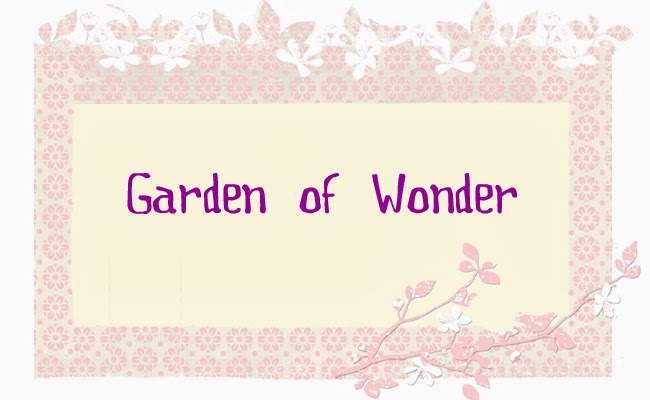



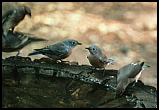 Put your birdbath in your garden, and the birds will find it quickly. We took the photo at left, of bluebirds and cedar waxwings, 15 minutes after we first filled our homemade birdbath. We hollowed out a shallow basin in a section of a pine log. It was so heavy that we had to roll it into place. And it was rough, but it was a major hit with the birds.
Put your birdbath in your garden, and the birds will find it quickly. We took the photo at left, of bluebirds and cedar waxwings, 15 minutes after we first filled our homemade birdbath. We hollowed out a shallow basin in a section of a pine log. It was so heavy that we had to roll it into place. And it was rough, but it was a major hit with the birds.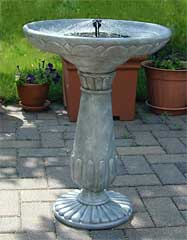
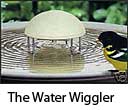 You can turn a still-water birdbath into a live-water bath by putting an inexpensive Water Wiggler in it. This is the same unit that makes the Water Rippling Birdbath work, but it's just the wiggler part. You put it in your own birdbath.
You can turn a still-water birdbath into a live-water bath by putting an inexpensive Water Wiggler in it. This is the same unit that makes the Water Rippling Birdbath work, but it's just the wiggler part. You put it in your own birdbath. Not where cats can hide.
Not where cats can hide.  On a pedestal.
On a pedestal. 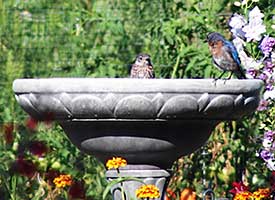 Don't forget to put yourself in the picture. Place the birdbath where you can see it from indoors, from your desk, dining room, or kitchen sink.
Don't forget to put yourself in the picture. Place the birdbath where you can see it from indoors, from your desk, dining room, or kitchen sink.
























 The Container
The Container Planting the Garden
Planting the Garden
 called "Garden mums" or "Hardy mums". Fall mums were once known as Chrysanthemums but taxonomists have recently changed their botanical name to Dendranthema x grandiflora. Fall mums are available in a wide selection of colors, flower types... shapes and sizes. Fall mums are a low maintenance easy to grow plant that can be kept in containers or grown in beds. They are drought resistant and generally free of insect and disease pests.
called "Garden mums" or "Hardy mums". Fall mums were once known as Chrysanthemums but taxonomists have recently changed their botanical name to Dendranthema x grandiflora. Fall mums are available in a wide selection of colors, flower types... shapes and sizes. Fall mums are a low maintenance easy to grow plant that can be kept in containers or grown in beds. They are drought resistant and generally free of insect and disease pests. receives full sun, but most cultivars can get by with a half day of direct sunshine. For ultimate growth, plant your new fall mums in fertile well drained soil. Poorly drained soil is the leading cause of winter mortality. Young plants... that is those in small containers should be planted 18" to 24" apart. Mature plants can be planted at any desired spacing providing they are planted no closer than just touching its neighbor. Fall mums in above ground containers need to be planted in a flower bed before the first hard frost!
receives full sun, but most cultivars can get by with a half day of direct sunshine. For ultimate growth, plant your new fall mums in fertile well drained soil. Poorly drained soil is the leading cause of winter mortality. Young plants... that is those in small containers should be planted 18" to 24" apart. Mature plants can be planted at any desired spacing providing they are planted no closer than just touching its neighbor. Fall mums in above ground containers need to be planted in a flower bed before the first hard frost! to pinch your fall mums in early spring. Once your plants have reached 4" - 6" remove about 1" to 2" of new growth on every shoot. After the plants have grown 3" - 5" shoots from the first pinching... its time to pinch again. Stop pinching your plants around mid July. This may seem like a drastic measure... but come fall you'll be rewarded with compact bushy plants that are robust with flowers.
to pinch your fall mums in early spring. Once your plants have reached 4" - 6" remove about 1" to 2" of new growth on every shoot. After the plants have grown 3" - 5" shoots from the first pinching... its time to pinch again. Stop pinching your plants around mid July. This may seem like a drastic measure... but come fall you'll be rewarded with compact bushy plants that are robust with flowers.







